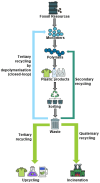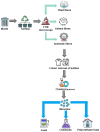The Current State-of-the-Art of the Processes Involved in the Chemical Recycling of Textile Waste
- PMID: 39860169
- PMCID: PMC11767914
- DOI: 10.3390/molecules30020299
The Current State-of-the-Art of the Processes Involved in the Chemical Recycling of Textile Waste
Abstract
The textile industry's rapid growth and reliance on synthetic fibres have generated significant environmental pollution, highlighting the urgent need for sustainable waste management practices. Chemical recycling offers a promising pathway to reduce textile waste by converting used fibres into valuable raw materials, yet technical challenges remain due to the complex compositions of textile waste, such as dyes, additives, and blended fabrics.
Keywords: PET; chemical recycling; depolymerisation; elastane; nylon; textiles.
Conflict of interest statement
The authors declare that they have no known competing financial interests or personal relationships that influenced the work reported in this paper.
Figures

















Similar articles
-
Recovery of pure PET from wool/PET/elastane textile waste through step-wise enzymatic and chemical processing.Waste Manag Res. 2025 Jun;43(6):969-979. doi: 10.1177/0734242X241276089. Epub 2024 Sep 20. Waste Manag Res. 2025. PMID: 39301986 Free PMC article.
-
Chemical Valorization of Textile Waste: Advancing Sustainable Recycling for a Circular Economy.ACS Omega. 2025 Mar 19;10(12):11697-11722. doi: 10.1021/acsomega.4c10616. eCollection 2025 Apr 1. ACS Omega. 2025. PMID: 40191322 Free PMC article. Review.
-
Advancing Textile Waste Recycling: Challenges and Opportunities Across Polymer and Non-Polymer Fiber Types.Polymers (Basel). 2025 Feb 26;17(5):628. doi: 10.3390/polym17050628. Polymers (Basel). 2025. PMID: 40076120 Free PMC article. Review.
-
Recycling and Degradation Pathways of Synthetic Textile Fibers such as Polyamide and Elastane.Glob Chall. 2025 Mar 13;9(4):2400163. doi: 10.1002/gch2.202400163. eCollection 2025 Apr. Glob Chall. 2025. PMID: 40255241 Free PMC article. Review.
-
Developing a compression moulded thermal insulation panel using postindustrial textile waste.Waste Manag. 2018 Sep;79:356-361. doi: 10.1016/j.wasman.2018.08.001. Epub 2018 Aug 7. Waste Manag. 2018. PMID: 30343764
Cited by
-
Impact of Chemicals and Processing Treatments on Thermo-Mechanical Recycling of Polyester Textiles.Molecules. 2025 Jun 26;30(13):2758. doi: 10.3390/molecules30132758. Molecules. 2025. PMID: 40649276 Free PMC article. Review.
References
-
- Leal Filho W., Perry P., Heim H., Dinis M.A.P., Moda H., Ebhuoma E., Paço A. An overview of the contribution of the textiles sector to climate change. Front. Environ. Sci. 2022;10:973102. doi: 10.3389/fenvs.2022.973102. - DOI
-
- Panhwar A., Sattar Jatoi A., Ali Mazari S., Kandhro A., Rashid U., Qaisar S. Water resources contamination and health hazards by textile industry effluent and glance at treatment techniques: A review. Waste Manag. Bull. 2024;1:158–163. doi: 10.1016/j.wmb.2023.09.002. - DOI
-
- Textile Exchange Releases Preferred Fiber and Materials Market Report. [(accessed on 23 May 2024)];Outdoor Ind. Compass. 2023 15:1–75. Available online: https://textileexchange.org/app/uploads/2023/11/Materials-Market-Report-....
Publication types
Grants and funding
LinkOut - more resources
Full Text Sources

